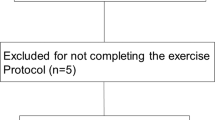Abstract
Objectives: Mild to moderate acute, endurance exercise has generally been shown to reduce blood pressure (BP) in hypertensive (HT) individuals. Whether a slightly more strenuous bout of exercise can elicit a greater and more prolonged BP reduction is unknown. Therefore, the purpose of this study was to examine the effects of two, 30-min exercise bouts, conducted at 50% and 75% of maximal oxygen uptake (VO2max), on the quantity and quality of BP reduction over a 24-h period.
Methods: Sixteen, Stage 1 and 2 non-medicated, HT (8 men/8 women) subjects were matched with normotensive (NT) men and women (n = 16). All subjects were evaluated for VO2max with a symptom-limited treadmill test and then completed a 30-min exercise bout at 50% and 75% of VO2max as well as a control (no exercise) session in random fashion on separate days. Twenty-four hour ambulatory BPs were measured after both the exercise and control settings. Data was assessed at 1, 3, 6, 12, and 24 h post-exercise and control session.
Results: A repeated-measures ANOVA showed non-significant differences between HT men and women and that both exercise intensities, relative to the control session, significantly (P < 0.05) reduced systolic (s) and diastolic (d) bps. nt subjects showed non-significant reductions following both intensities. the reductions in the ht men and women averaged 4 and 9 mm hg (sbp)/5 and 7 mm hg (dbp) for 50% and 75%, respectively. on average, the ht subjects (men and women combined) maintained significant sbp reductions for 13 h after the 75% bout compared to 4 h after the 50% intensity. likewise, dbp was reduced for an average of 11 h following the 75% bout compared to 4 h after the 50% intensity.
Conclusions: These results suggest that an exercise bout conducted between 50–75% VO2max significantly decreases SBP and DBP in HT subjects and that a greater and longer-lasting absolute reduction is evident following a 75% of maximum bout of exercise.
Similar content being viewed by others
Author information
Authors and Affiliations
Corresponding author
Rights and permissions
About this article
Cite this article
Quinn, T. Twenty-four hour, ambulatory blood pressure responses following acute exercise: impact of exercise intensity. J Hum Hypertens 14, 547–553 (2000). https://doi.org/10.1038/sj.jhh.1001106
Received:
Revised:
Accepted:
Published:
Issue Date:
DOI: https://doi.org/10.1038/sj.jhh.1001106
- Springer Nature Limited
Keywords
This article is cited by
-
The effects of acute exercise on stress reactivity assessed via a multidimensional approach: a systematic review
Journal of Behavioral Medicine (2024)
-
Active intervals between sets and exercise of resistance exercises potentiate the magnitude of post-exercise hypotension in middle-aged hypertensive women
European Journal of Applied Physiology (2024)
-
Does Compassion Predict Blood Pressure and Hypertension? The Modifying Role of Familial Risk for Hypertension
International Journal of Behavioral Medicine (2020)
-
High-intensity interval exercise promotes post-exercise hypotension of greater magnitude compared to moderate-intensity continuous exercise
European Journal of Applied Physiology (2019)
-
Acute responses of hemodynamic and oxidative stress parameters to aerobic exercise with blood flow restriction in hypertensive elderly women
Molecular Biology Reports (2018)




